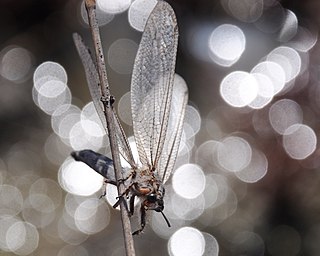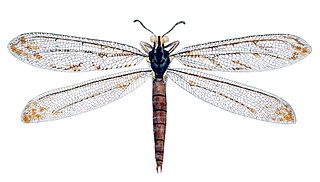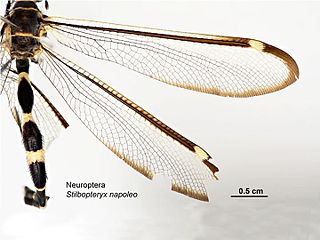
The antlions are a group of about 2,000 species of insect in the neuropteran family Myrmeleontidae, known for the fiercely predatory habits of their larvae, which in many species dig pits to trap passing ants or other prey. The adult insects are less well known, due to their relatively short lifespans compared to the larvae. Adults mostly fly at dusk or after dark, and may be mistakenly identified as dragonflies or damselflies; they are sometimes known as antlion lacewings. In North America, the larvae are sometimes referred to as doodlebugs because of the strange marks they leave in the sand.

Acanthaclisini is a tribe in the antlion subfamily Acanthaclisinae.

Glenurus is a genus of antlions in the family Myrmeleontidae. There are about 12 described species in Glenurus.

Vella is a genus of antlions in the family Myrmeleontidae. There are about five described species in Vella.

Dendroleon is a genus of antlions in the family Myrmeleontidae. There are more than 20 described species in Dendroleon.
Paranthaclisis is a genus of antlions in the family Myrmeleontidae. There are five described species in Paranthaclisis.
Eremoleon is a genus of antlions belonging to the family Myrmeleontidae. The species of this genus are found from the southern United states to Central America.

Stilbopteryx is a genus of antlions belonging to the family Myrmeleontidae.
Speleon is a genus of cave-dwelling antlions, that is, the genus belongs to the family Myrmeleontidae.
Newleon is a genus of cave-dwelling antlions, that is, the genus belongs to the family Myrmeleontidae.
Froggattisca is a genus of cave-dwelling antlions, that is, the genus belongs to the family Myrmeleontidae.
Froggattisca kakadu is a species of cave-dwelling antlions.
Froggattisca rennerensis is a species of cave-dwelling antlion, endemic to the Northern Territory.
Froggattisca testacea is a species of cave-dwelling antlion, endemic to the Northern Territory.
Froggattisca anicis is a species of cave-dwelling antlion, endemic to the Northern Territory and Western Australia.
Froggattisca gemma is a species of cave-dwelling antlion, endemic to Queensland and Western Australia.
Froggattisca rieki is a species of cave-dwelling antlion, endemic to the Northern Territory and Western Australia.
Froggattisca radiostriata is a species of cave-dwelling antlion, endemic to Queensland and Western Australia.
Heoclisis fulva is a species of cave-dwelling antlion, found in Australia, in Queensland, Western Australia and the Northern Territory.






